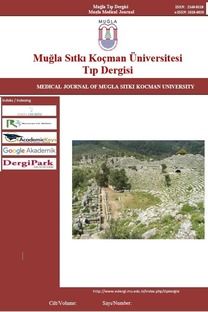İn Vitro Fertilizasyon ile Gebe Kalan Hastaların Gebelik Sonuçlarının Değerlendirilmesi: Tersiyer Merkez Deneyimi
Çoğul Gebelik, Erken Doğum, Perinatal Ölüm
Evaluation of Pregnancy Results of in Vitro Fertilization Patients: A Tertiary-Center Experience
Multiple Pregnancy, Preterm Birth, Perinatal Death,
___
- 1. Lei LL, Lan YL, Wang SY, Feng W, Zhai ZJ. Perinatal complications and live-birth outcomes following assisted reproductive technology: a retrospective cohort study. Chin Med J (Engl). 2019;132(20):2408-16.
- 2. Messerlian C, Maclagan L, Basso O. Infertility and the risk of adverse pregnancy outcomes: a systematic review and meta-analysis. Hum Reprod. 2013;28(1);125-37.
- 3. Behram M, Oğlak SC, Başkıran Y, Süzen Çaypınar S, Akgöl S, Tunç Ş, et al. Maternal serum IL-22 concentrations are significantly upregulated in patients with preterm premature rupture of membranes. Ginekol Pol. 2021;92(9):631-6.
- 4. Oğlak SC, Bademkıran MH, Obut M. Predictor variables in the success of slow-release dinoprostone used for cervical ripening in intrauterine growth restriction pregnancies. J Gynecol Obstet Hum Reprod. 2020;49(6):101739.
- 5. Behram M, Oğlak SC, Dağ İ. Circulating levels of Elabela in pregnant women complicated with intrauterine growth restriction. J Gynecol Obstet Hum Reprod. 2021;50(8):102127.
- 6. Behram M, Oğlak SC, Doğan Y. Evaluation of BRD4 levels in patients with early-onset preeclampsia. J Gynecol Obstet Hum Reprod. 2021;50(2):101963.
- 7. Oğlak SC, Obut M. Expression of ADAMTS13 and PCNA in the placentas of gestational diabetic mothers. Int J Morphol. 2021;39(1):38-44.
- 8. Fujimoto A, Morishima K, Harada M, Hirata T, Osuga Y, Fujii T. Elective single-embryo transfer improves cumulative pregnancy outcome in young patients but not in women of advanced reproductive age. J Assist Reprod Genet. 2015;32(12):1773-9.
- 9. Dobrosavljevic A, Rakic S, Mihajlovic S. Risk of spontaneous preterm labor in pregnancies achieved by in vitro fertilization and complicated with severe form of ovarian hyperstimulation syndrome: A case control study. Pak J Med Sci. 2019;35(4):923-8.
- 10. Halliday J. Outcomes of IVF conceptions: are they different? Best Pract Res Clin Obstet Gynaecol. 2007;21(1):67-81.
- 11. Helmerhorst FM, Perquin DA, Donker D, Keirse MJ: Perinatal outcome of singletons and twins after assisted conception: a systematic review of controlled studies. BMJ. 2004;328:261.
- 12. Dhalwani NN, Boulet SL, Kissin DM, et al. Assisted reproductive technology and perinatal outcomes: conventional versus discordant-sibling design. Fertil Steril. 2016;106(3):710-6.
- 13. Qin JB, Wang H, Sheng X, Xie Q, Gao S. Assisted reproductive technology and risk of adverse obstetric outcomes in dichorionic twin pregnancies: a systematic review and meta-analysis. Fertil Steril. 2016;105(5):1180-92.
- 14. Manoura A, Korakaki E, Hatzidaki E, Bikouovarakis S, Papageorgiou M, Giannakopoulou C: Perinatal outcome of twin pregnancies after in vitro fertilization. Acta Obstet Gynecol Scand. 2004;83:1079-84.
- 15. Kouhkan A, Khamseh ME, Pirjani R, et al. Obstetric and perinatal outcomes of singleton pregnancies conceived via assisted reproductive technology complicated by gestational diabetes mellitus: a prospective cohort study. BMC Pregnancy Chilbirth. 2018;18(1):495.
- 16. Qin J, Liu X, Sheng X, Wang H, Gao S. Assisted reproductive technology and the risk of pregnancy-related complications and adverse pregnancy outcomes in singleton pregnancies: a meta-analyses of cohort studies. Fertil Steril. 2016;105(1):73-85.
- 17. Neumann K, Cirkel C, Rody A, Beyer DA. Do ART patients face higher C-section rates during their stage of delivery: A German monocenter experience. Arch Gynecol Obstet. 2017;259(2):481-5.
- 18. Declercq E, Luke B, Belanoff C, et al: Perinatal outcomes associated with assisted reproductive technology: the Massachusetts Outcomes Study of Assisted Reproductive Technologies (MOSART). Fertil Steril. 2015;103(4):888-95.
- 19. Sullivan-Pyke CS, Senapati S, Mainigi MA, Barnhart KT. In Vitro fertilization and adverse obstetric and perinatal outcomes. Semin Perinatol. 2017;41(6):345-53.
- 20. Klemetti R, Gissler M, Sevón T, Koivurova S, Ritvanen A, Hemminki E. Children born after assisted fertilization have an increased rate of major congenital anomalies. Fertil Steril. 2005;84(5):1300-7.
- 21. Reefhuis J, Honein MA, Schieve LA, Correa A, Hobbs CA, Rasmussen SA; National Birth Defects Prevention Study. Assisted reproductive technology and major structural birth defects in the United States. Hum Reprod. 2009;24:360-6.
- ISSN: 2148-8118
- Yayın Aralığı: Yılda 3 Sayı
- Başlangıç: 2014
- Yayıncı: Muğla Sıtkı Koçman Üniversitesi
Süleyman Cemil OĞLAK, Ilgın TÜRKÇÜOĞLU, Şeyhmus TUNÇ
Evin İLTER BAHADUR, Esra ARUN ÖZER
Nadir Bir Olgu Sunumu: Kronik Böbrek Yetmezlikli Hastada İzole Çekal Nekroz
Burak UÇANER, Muharrem ÖZTAŞ, Çağdaş KARAMAN, Baki TÜRKOĞLU, Şebnem ÇİMEN
Distal Hipospadias Cerrahisinde Daha İyi Bir Görünüme Yol Açan Modifikasyon: Frenuloplasti
Non-Hodgkin Lenfoma Olgusunda Bilateral İzole Eş Zamanlı Superior Oftalmik Ven Trombozu
Bünyamin GÜNEY, Murat Yunus ÖZDEMİR, Önder YENIÇERI
Klinik Nörofizyoloji Bölümünde Elektroensefalografi İstemlerinin Analizi
Vedat Semai BEK, Gülnihal KUTLU, Yasemin ÜNAL, Mahmut Bilal ÇAMAN
Muğla’da Sürekli Tıp Eğitimi - Muğla Cerrahi Toplantıları
Acil Servislerden Yoğun Bakım Ünitesine Kabul Edilen Yaşlı Erişkin Hastaların Sonuç Belirleyicileri
Hüseyin MUTLU, Ekrem Taha SERT, Ayhan SARITAŞ, Kamil KOKULU
Trakea Yerleşimli Adenoid Kistik Karsinom: Olgu Sunumu
Deniz KÜTRİ, Alaattin ÖZEN, Suzan SAYLISOY
Pandemi Döneminde ve Pandemi Öncesi Dönemde Acil Servise Başvuran Hastaların Karşılaştırılması
